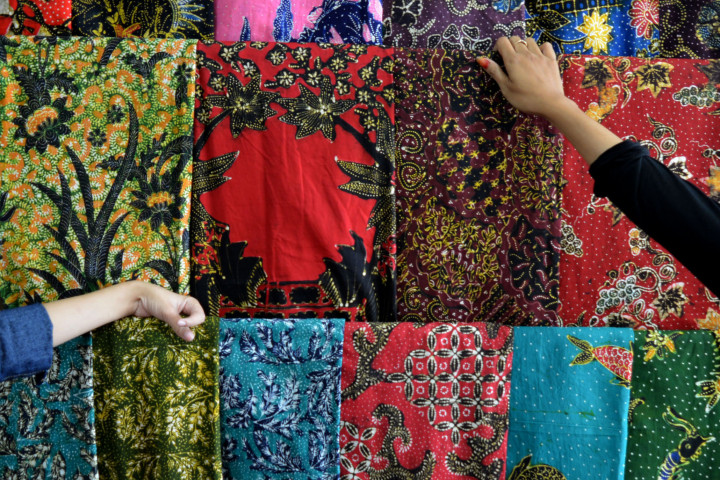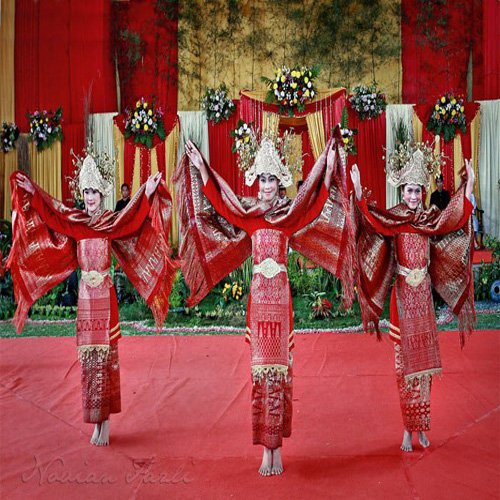The Ikat Tapestry that binds India and Indonesia

A few days into my tenure in Sumatra, I was presented with ‘Ulos’ at various public events as a mark of respect and honour. I was blown away by the texture and intricate designs of this drapery or shawl. But it also gave me a sense of strange familiarity as it reminded me of several textile items produced in certain parts of India. After a little research about its historical traditions, I have come to treasure my collection. Surely, Ikat is one of the many traditions that bind India and Indonesia.
Ulos is the handwoven fabric which is an integral part of the Batak community of North Sumatra. What began as a traditional piece of daily wear in that community has evolved into a signature textile product of North Sumatra. Ulos is used for special occasions, festivals and to honour important guests. It is just one of Indonesia’s many other special textile creations that are being produced under its now famous ‘Ikat’ tradition.

Ulos of North Sumatra by Batak community (Wikicommons)

Batak community wearing traditional Ulos in Samosir Island
Considered the oldest form of textile making, the Ikat tradition probably dates back to later bronze age, spread across 30 countries. The story of Ikat tradition across the world is a fascinating one. It points to the innate desire of mankind to embellish cloth with designs and colours. It's evolution over the years is equally fascinating as it narrates a saga of human creativity and sharing of acquired techniques and skills through trade and people to people contacts.
Given its wide spread, it is not easy to zero in on the exact place of its origin of Ikat, but many historians point out that Ikat was present in Indonesia about 2000 years ago. In support of this, historians point to the presence of ikat weaving with Dongson cultural decorations such as geometric motifs, trees, flora, fauna and even humans. They point to the cultural influence of the Last Zhou with asymmetrical designs in the form of animals or humans found on the Iban Dayak Ikat, Toraja, Batak (Ulos), and Timor.
On the other hand, history also records that the the oldest surviving example of an Indian Ikat in Odia style found in a Pharaohs tomb in Egypt, at least 5,000 years ago. Though the Indian Ikat predates the Indonesian one, it may be incorrect to assume that the Ikat in Indonesia was a cultural import from India. Just suffice it to say that this technique is very ancient and has been enriched by the close ancient trade routes binding nations and civilization in a tapestry of cultural synergy.
India and Indonesia, being important flag posts on the ancient silk trade route, have been part of this historic cultural exchange, which includes other South east Asian countries, China, Central Asia and parts of Latin American.
Like in Indonesia, Ikat is deep rooted in India too, but interestingly, this age old technique is known worldwide by the generic term Ikat which is Indonesian. 'Tenun Ikat' is a generic Indonesian word, meaning "to tie" or "to bind". The word 'Mengikat" meaning to bind or tie, is also used in Malaysia and Indonesia.
It is interesting that the word encapsulates the entire process involved in the making of an Ikat fabric. For example, the word 'tali' means threads or ropes, being Ikat (tied, bound, knotted) before being put in celupan (dye by dipping method), then berjalin (woven, intertwined) resulting in berjalin ikat. Today, however, because of its reputation and popularity, it has become a loan word to delineate a process and the cloth itself, regardless of origin of place or its pattern styles.
Instances of Ikat traditions in early Indian societies find mention in several historical texts and architectural paintings, edicts and murals. For example, the Buddhist text 'Lalitavistara Sutra' written in 3rd century mentions about fabric called "Vichitra Patola' of Gujarat. The influence of Patola designs can also seen on the Palembang Cinde shawl (Songket) or Flores cloth of Sumatra. Another historical text 'Manasollas of Someswara' written in 12th century reaffirms the varieties of the tie-dye technique of Patola tradition of Gujarat.
But what can be said with some certainty is that the Indian Patola Ikat from Gujarat influenced the Ikat tradition in Indonesia around 1400-1600 AD. When Gujarati merchants traded their glittering silk Patola textiles with several Indonesian islands for spices, metals, aromatic resins etc, this vibrant designs, colours and motifs of double Ikat technique, fascinated the Indonesian weavers. The double ikat were previously unseen by the Indonesian people, who immediately replicated them using the single Ikat technique drawn on local aesthetics, dye colours and local cultural motifs. This tradition was patronized by many Hindu and Buddhist Kingdoms. Patola like cloths can be seen even today in many parts of Indonesia.
The famous murals of the Ajanta caves in Maharashtra belonging to 7th century, depict several Ikat designs of 'Bandhani'. The Veerabhadra Swamy temple in Lepakshi, Andhra Pradesh, also depict geometrical Ikat designs of the weaving tradition of Paagadu Bandhu and its most famous product Telia Rumal. This is practiced in Nalgonda and Prakasam districts of today's Telangana.
Ikat in Ajanta Murals | Wikimedia Commons
The Telia Dupatta and Rumal, with its red, black and white chequered pattern was used as lungis by fishermen in those days and got exported to Myanmar, parts of Africa and Middle East somewhere around the 18th century.

Completed double ikat using the Telia Rumal technique
Similarly, in Odisha, the Ikat tradition, known as 'Bandha' has been practiced for centuries especially in Sambalpur, Cuttack and Bargarh districts. Most Bandha products of Odisha were single warped ones, except for the Saktapur design which is a double Ikat. The design has been inspired by Chaupad, a local board game and has bright red and white squares against a black canvass.
Distinctive motifs on Odishan ikat, or bandha
The Sambalpuri saris which are generally used during festive and ceremonial occasions, usually have animal, floral and other motifs derived from Odisha's mythology, its coastal influences and rituals associated with weddings and ceremonies. The Pasapalli Ikat saree of Odisha & Puttapaka saree of Telegana are also made with the same double Ikat technique used in making of Sambalpuris.
Indonesia had been using the single Ikat technique from early times. The single ikat method is either only the warp (twist) or the weft (fill-tied and dyed), with different colours so as to create patterns. The double ikat technique, which is the more difficult and in vogue in India for a very long time, involves both the warp and weft, making the weaving process complex and ornate. Indonesia most likely inherited the double ikat technique from India during the 12-14 centuries. Today, the double ikat is produced only in three countries: India, Japan and Indonesia.
In Indonesia, the double ikat tradition has been followed only in Tenganan in East Bali. Tenganan is a prime example of the special double Ikat tradition crossing borders. It imbibed the double Ikat technique from the Patola designs of Gujarat and internalized them to suit local tradition and cultural preferences. Some of the Tenganan double ikat motifs are taken directly from the patola tradition.
Stories abound about how Gujarati Indian traders would convey to their Indonesian counterparts about the types of Patola Ikat being produced and Indian traders would then customize their products to the requirements and fancies of the Indonesian traders.
Double Ikat at Tenganun Village, East Bali
The Balinese double ikats are called Geringsing cloth, which has high ceremonial significance in Bali and acquired legendary status today. They use to be worn as ritual costumes during religious cermonies, but today Tenganan has become a regular fixture on the international heritage tourism circuit and on any tourist trail of an international visitor.

Young Women dressed in Geringsing in Bali

Double Ikat at Tenganun Village, East Bali
It is also important to mention that the Indonesian Ikat textile tradition has not entirely adopted Indian or other external styles and techniques, but continued to flourish based on their rich local weaving techniques. Indonesia also had a rich and deep knowledge about dyeing techniques, before intense trade contacts with India resulted in cross cultural influences.
Since weaving and batiking have been a vital and thriving component of way of life in Indonesia for several years, naturally it has other textile techniques beyond Ikat. Three major examples are Batik, Songket and Prada.
Batik does not come under the Ikat technique of textile making, but is as specialized and painstaking as the double Ikat. Batik is made using a wax resist with the pattern waxed onto a plain undyed cloth that is already woven. Ikat is also resist dyed, but the threads of the fabric itself carries the resist.
Songket is a variant of the Ikat tradition in which the cloth is hand loomed, but additional wefts are employed using metal wrapped thread to give it a more ornate patterns and a lustrous look. Songket tradition is common in parts of Sumatra, East Bali, South Sumatra (esp Jambi) and in the Minangkabau villages in West Sumatra. It is signifies wealth and high social standing of the user. An interesting point is that the Balinese Songket draws inspiration from Wayang shadow puppet shows, which are linked to Indian epics Ramayana and Mahabharata.
Songket of North Sumatra
Prada is a highly decorated form of batik, where regular Batik cloth is enhanced with gold coated or threads designs lending a flashy shiny exterior. Prada has been sought by the modern fashion industry especially for the evening gowns.
From the Sari to the Sarong, India and Indonesia have traversed an incredible cultural journey together in last 1000 years. In both countries, Ikat originated as a product of local genius and cultural experience. Both have been witness to the changing influences of their respective historical eras and witnessed amazing innovation in their respective traditions. It is also a tribute to both countries that they adapted to imposed external cultural influences and reinvent Ikat to suit changing times, while maintaining their original cultural identity.Both countries used almost similar techniques and began as unsullied ethnic traditions, yet they have produced highly prized signaturized textile products of high national significance for their countries. Sambalpuri, Patola, Paagadu Bandhu, Bandini, Jamdani to name a few from India and Batik, Prada, Geringsing and Songket of Indonesia.
The Ikat traditions has evoked awe and intrigue among Western researchers for years. A unique perspective has been offered by researchers at the Textile museum in Washington who are of the view that Ikat principles may be founded on basic geometry as Ikat employs precise geometric patterns & colour divisions that are repeated.
Assuming that the Ikat artisans of the day had great conceptual understanding of mathematics, were mathematical principles and concepts were transmitted from India to Indonesia and other parts, along with Ikat know-how ? It is a matter of speculation.

Sumatra dancers wearing Songket garments







Comments
Post a Comment